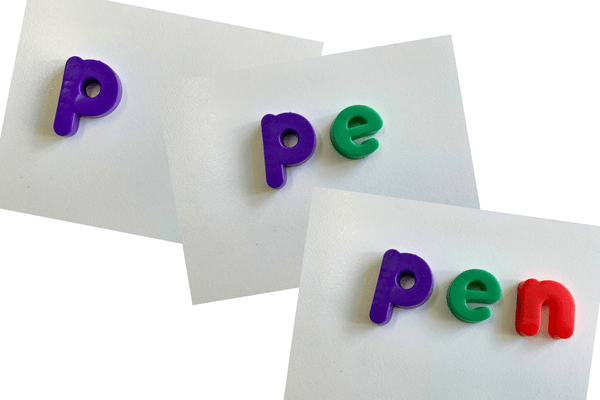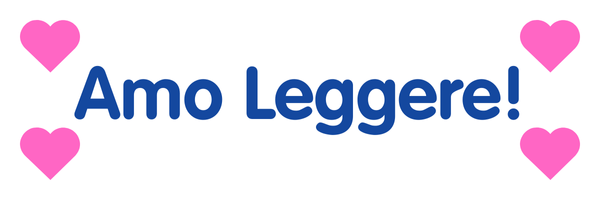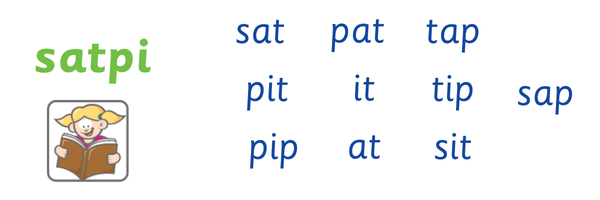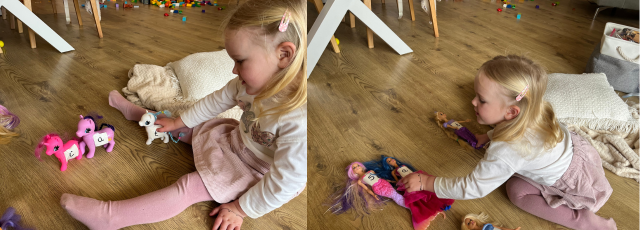
Most parents understand the importance of learning the sounds. You might overhear an eager parent in the park: “That’s right, Ella, it’s an aaaannnt—’a, a, a’!”. But what comes next is just as important – and often trickier. Here’s how to help your child move from recognising sounds to blending them into their very first words – at home!
It’s the gluing of sounds together to read a word. A child breaks the word apart into its individual sounds and puts them back together to read a word.
 Blending the sounds together from left to right.
Blending the sounds together from left to right.
As fluent readers, we recognize words instantly—we don’t need to break them into individual sounds anymore. But when faced with an unfamiliar word, we return to the basics, relying on phonics to decode words.
Try reading this Italian aloud:
 “I love reading” in Italian.
“I love reading” in Italian.
Unless you speak Italian, you likely used your knowledge of English phonics to decode “Leggere”. Did you pronounce “-ere” like in “where”? (which isn’t correct, but hey, we’re not learning Italian here!). This is what children do when they encounter words that are unfamiliar; they use their knowledge of the phonics code to break the words apart and then stitch them back together. For.Each.And.Every.Word! No wonder the first few years of school are so tiring!
Blending the sounds together to read is a temporary process. Phonics is used less and less as a child recognises more words by sight. As a child progresses through primary school, phonics gets put in their back pocket, ready for when an unknown word is encountered. Have a watch as this child moves through the years from oral blending, to blending simple words, to blending every other word in sentences and finally reaching fluent reading:
Before jumping in, here are three signs your child is ready to start blending:
You don’t need to wait till your child knows all the sounds of the alphabet. In fact, you shouldn’t wait. As soon as they have five or six sounds — start!
At home, keep up the oral blending: you can model it aloud, often and everywhere:
You might also like to play “what am I saying” to keep up the oral blending:

From the 4 or 5 sounds they know, use them to blend together 2 to 3 sound words. 100% of the sounds in the words should be known. No extra sounds — no surprises! Look at the words you can read with only 5 sounds:
 The 10 words you can make with only the sounds – satpi.
The 10 words you can make with only the sounds – satpi.
Use your arm: tap your shoulder for the first sound, elbow for the second, wrist for the third, then sweep your hand along your arm to blend. Face paint makes this a fun, multi-sensory and messy way to cement the concept.
Don’t get any books out yet. If your child can physically grasp the concept of blending; bashing, smashing, or squishing — it means they’ve cleared a major hurdle. Bash the cars together, join the magnetic letters, squish together the play-dough, get the teddies to hold hands.
Tap each item as you say the sounds, then swipe your hand across them to say the whole word.
 Blending the toy-sounds together to read the word.
Blending the toy-sounds together to read the word.
Blending is hard work for young brains. Think of it like learning to drive: at first, it’s slow and clunky. Over time, it becomes second nature. Your child might forget which sound comes next or lose track in the middle of a word. That’s where you come in; guide, remind, and lighten the load.
If blending is still tough, try these three blending techniques to see which one helps the penny drop: isolated, successive or final blending. Watch teacher Tina demonstrate:

Want a more in-depth look at how teachers approach blending? Read our full guide to teaching blending in the classroom.
Once blending clicks, it opens the door to spelling, tricky words and sentence reading! Phonics Hero guides your child through each of these steps, with games and practice matched to their level. You can play Phonics Hero on the Phonics Hero app or computer — try it out with a free 7-day trial:
Blending is a skill built with consistent, low-stress practice. Some kids get it quickly; others take weeks. If your child feels frustrated, take a break and try again tomorrow. It will click!